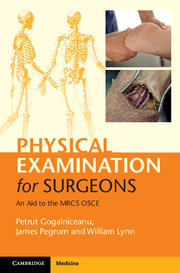Book contents
- Frontmatter
- Dedication
- Contents
- List of contributors
- Introduction
- Acknowledgments
- List of abbreviations
- Section 1 Principles of surgery
- Section 2 General surgery
- Section 3 Breast surgery
- Section 4 Pelvis and perineum
- Section 5 Orthopaedic surgery
- Section 6 Vascular surgery
- Section 7 Heart and thorax
- Section 8 Head and neck surgery
- Section 9 Neurosurgery
- Section 10 Plastic surgery
- Section 11 Surgical radiology
- 44 Principles of plain film
- 45 Chest x-ray
- 46 Abdominal x-ray
- 47 Mammogram
- 48 Facial x-ray
- 49 Cervical spine x-ray
- 50 Shoulder x-ray
- 51 Elbow x-ray
- 52 Wrist and distal forearm x-ray
- 53 Pelvis and hip x-ray
- 54 Knee x-ray
- 55 Foot and ankle x-ray
- 56 Principles of CT
- 57 Head CT
- 58 Chest CT
- 59 Abdomen CT
- 60 Aorta CT
- 61 Kidneys, ureter and bladder CT
- 62 Lower limb CT angiogram
- Section 12 Airway, trauma and critical care
- Index
61 - Kidneys, ureter and bladder CT
from Section 11 - Surgical radiology
Published online by Cambridge University Press: 05 July 2015
- Frontmatter
- Dedication
- Contents
- List of contributors
- Introduction
- Acknowledgments
- List of abbreviations
- Section 1 Principles of surgery
- Section 2 General surgery
- Section 3 Breast surgery
- Section 4 Pelvis and perineum
- Section 5 Orthopaedic surgery
- Section 6 Vascular surgery
- Section 7 Heart and thorax
- Section 8 Head and neck surgery
- Section 9 Neurosurgery
- Section 10 Plastic surgery
- Section 11 Surgical radiology
- 44 Principles of plain film
- 45 Chest x-ray
- 46 Abdominal x-ray
- 47 Mammogram
- 48 Facial x-ray
- 49 Cervical spine x-ray
- 50 Shoulder x-ray
- 51 Elbow x-ray
- 52 Wrist and distal forearm x-ray
- 53 Pelvis and hip x-ray
- 54 Knee x-ray
- 55 Foot and ankle x-ray
- 56 Principles of CT
- 57 Head CT
- 58 Chest CT
- 59 Abdomen CT
- 60 Aorta CT
- 61 Kidneys, ureter and bladder CT
- 62 Lower limb CT angiogram
- Section 12 Airway, trauma and critical care
- Index
Summary
Introduction
‘This is an unenhanced low-dose CT scan of the kidneys, ureter and bladder in axial/coronal/sagittal view.’
Summary
AAir: perforation from GI or urinary system
BBlood: high-density haemorrhage from tumour, trauma or obstruction
CCalcifications: renal, collecting system, ureteric, bladder calculi, prostate calcification
DDilatations: renal or ureteric obstruction
Checklist: ‘KUBE’
Kidney
• Site – horseshoe or ectopic kidney
• Size – masses, obstruction (calculi), reflux
• Content – stones, staghorn calculi
Ureter
• Site – on psoas: mass/lesion
• Size – obstruction:
• unilateral = calculi, ureteric or bladder tumour, stricture from previous surgery
• bilateral = bladder outflow obstruction
Bladder
• Air (dark): trauma, instrumentation or fistula to bowel (e.g. Crohn' s disease) or infection
• Calcification of wall: schistosomiasis, TB infection, post radiation
Everything else
• Retroperitoneal and peritoneal spaces
• The 3 Fs – fat inflammation, fluid collection (e.g. urinoma) and “fast” (acute) haemorrhage
• Prostatic calcification may be detected on a KUB radiograph and is usually a sign of chronic inflammation
Quick look
• Bowel dilatation
• Free fluid, collection or air
• ‘ Dirty fat ’ around other organs, e.g. liver, gall bladder, pancreas
Tips
The scan is specifically an unenhanced ‘grainy’ low-dose scan looking for calculi.
CT KUB scans are good for artefacts – e.g. stents, calcifications and air – but lack of contrast limits diagnosis of solid organ pathology.
However, ‘dirty’ -looking fat or fluid around solid or hollow organs suggests inflammation, which requires a post-contrast scan.
If a ureteric cancer is suspected CT IVU should be requested (a delayed phase post-contrast scan). Contrast fills the renal pelvis, ureter and bladder, highlighting any mass or filling defects.
The commonest findings in exams are calcifications and secondary signs of obstruction (hydronephrosis or hydroureter).
- Type
- Chapter
- Information
- Physical Examination for SurgeonsAn Aid to the MRCS OSCE, pp. 469 - 470Publisher: Cambridge University PressPrint publication year: 2015



